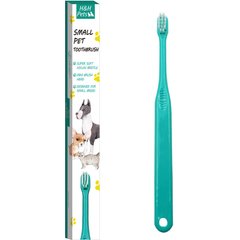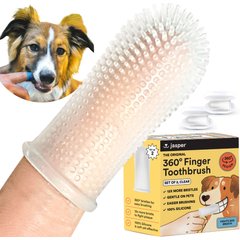How To Brush a Cat’s Teeth
Adobe Stock/Garnar
Routinely brushing your cat’s teeth is one of the most important things you can do to keep your feline friend healthy and happy. It’s also surprisingly easy—as long as you know how to get your home dental-care program up and running.
Here’s everything you need to know about brushing cats’ teeth.
Should I Brush My Cat’s Teeth?
The effects of not brushing your cat’s teeth are dire and can start far earlier than you might think.
Without proper dental care, up to 70% of cats will develop periodontal disease by the time they are 2 years old. Why does this matter? Not only is periodontal disease very painful, but it can also lead to infections, tooth loss, and health problems throughout the body.
Periodontal disease is usually caused by plaque and tartar deposited on a cat’s teeth. Both are extremely irritating and lead to symptoms like:
-
Inflamed gums that are red, painful, and bleed easily
-
Infections around the teeth
-
Teeth that become loose and may eventually fall out as their supporting structures (soft tissues and bone) are destroyed
And what starts in the mouth doesn’t necessarily stay there. While there hasn’t been a lot of research specific to cats, one study found an increased risk of chronic kidney disease in cats that had periodontal disease, particularly when the dental disease was in its more advanced stages.
Thankfully, preventing periodontal disease isn’t hard. You simply need to remove plaque from a cat’s teeth before it can harden into tartar, and the best tool for the job is a pet-specific toothbrush.
When To Start Brushing Cat Teeth
Brushing cats’ teeth will only be effective if the teeth are clean to begin with. This is why it’s ideal to start brushing a kitten’s teeth as soon as they are weaned. Their teeth will be clean, and the kitten will grow up thinking that having their teeth brushed is just a normal part of life.
Talk to your veterinarian if you’re looking to start brushing an older cat’s teeth for the first time. You can’t remove hard tartar or address preexisting periodontal disease with a toothbrush. Your veterinarian will likely need to perform a dental cleaning before you start brushing your cat’s teeth at home.
What You Need To Brush Cat Teeth
The tools needed to brush cat teeth aren’t expensive or difficult to find. You’ll need:
-
Cat treats to reward your cat for a job well done
-
A small, soft toothbrush like the H&H Pets Cat & Small Dog Toothbrush. Some pet parents prefer using a finger brush, like the Jasper Finger Dog & Cat Toothbrush, which can work well, too.
-
Toothpaste designed specifically for cats. Pick a flavor your cat likes. Virbac C.E.T. Enzymatic Dog & Cat Toothpaste comes in poultry, beef, and seafood flavors.
How To Brush a Cat’s Teeth
Now that you have everything you need, it’s time to get started.
1. Start Slow
First, get your cat used to having their mouth and teeth touched.
Sit down with your kitty in your lap and a few treats nearby. Gently pet their head and face, lift their lip, and touch their teeth. Give them treats after a few seconds and be done for the day.
Do this for as many days as needed until your cat stays relaxed and happy the whole time. Gradually increase the amount of time each session lasts, with 30 seconds as your ultimate goal.
End every session with a few treats and lots of praise.
2. Introduce the Toothpaste and Toothbrush
Put a tiny bit of cat toothpaste on your finger and touch your cat’s gums and teeth. Let your cat investigate their toothbrush so they become familiar with it. Do this for a few days until everything is going smoothly.
Finally, put a little toothpaste on the toothbrush, but just touch your cat’s teeth with the toothbrush; don’t brush. The goal here is to give your cat time to get used to the taste and feel of the toothpaste and toothbrush, not to clean their teeth.
Take a few days to build up to the point where your cat will let you touch their teeth and gums with the toothbrush and toothpaste for around 30 seconds. Keep handing out the treats and praise!
3. Begin Brushing
Now it’s time to start brushing your cat’s teeth. Replace a few seconds of tooth touching with a little actual brushing, then go back to your old pattern.
Over several days, swap out more and more of the touching with actual brushing using the toothbrush and toothpaste. Start with the front teeth (paying special attention to the gumline) but make sure you eventually work your way to the back—that is where most plaque and tartar accumulate.
Once you can brush the outside surfaces of all your cat’s teeth (don’t worry about the inside surfaces) you’ve successfully trained your cat to have their teeth brushed!
Talk to your veterinarian if you’re looking to start brushing an older cat’s teeth for the first time. You can’t remove hard tartar or address preexisting periodontal disease with a toothbrush.
How Often To Brush a Cat’s Teeth
Aim to brush your cat’s teeth every day—it’s just 30 seconds, after all! The soft plaque that can be removed with a toothbrush can start to harden into tartar in just 24–48 hours. Missing a day here and there is not a big deal, but anything less than every other day won’t really do much good.
Tips for Keeping Cat Teeth Clean
While brushing cats’ teeth is certainly best, pet parents do have a few other options for keeping cat teeth clean. These products can be used along with toothbrushing. Or, if your cat simply won’t stand for having their teeth brushed, they’re better than nothing:
Talk to your veterinarian about what type of home dental care is most appropriate for your cat.



